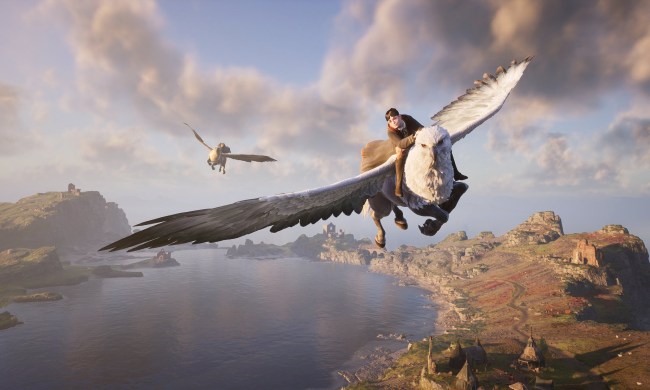
No one has played every video game. Not even the experts. In Backlog, Digital Trends’ gaming team goes back to the important games they’ve never played to see what makes them so special … or not.
After hearing the somewhat overlooked Terraria received its final update an astonishing nine years after release, I dusted my copy off ready to give it a real run. The cover was the same, with its odd mix a grassy 8-bit logo and a warrior in armor in an entirely different art style. But that’s actually the charm of the game.
Playing Terraria in 2020, your thoughts will likely turn toward Stardew Valley (though, Terraria was released first) thanks to their similar aesthetic and shared mix of farming and fighting. But there’s more than meets the eye. Literally.
As hinted at by its name, Terraria lets — encourages, really — players to explore the underbelly of the world. You can mine for treasures or merely explore. And it’s no walk in the park. You’ll often be caught by monsters, some of which wouldn’t be out of place in your typical action-platformer.
More than a clone
It might not have the broader name recognition of the titles it’s compared to, but Terraria more than holds its own. Fans have shared their worlds and homes all over the internet, and it’s sold a stunning 30 million copies. The fact the community is still active and celebrating the last update, almost a decade after release, is impressive.
Which, of course, made me wonder. What am I missing?
Every new player is greeted by an NPC guide that gives basic instructions, but I still felt lost. I tried venturing on my own to explore a cavern and struggled to make my way back to land once night set in the world was covered in darkness.
This is where comparisons to Stardew Valley come in. They both drop players in with little direction as they take on farming, mining, battling, and relationships with NPCs. You are free to choose what to focus on in each game, whether that means becoming a master battler or building up your homestead. Overall, the gameplay is similar and the two are often compared.
However, Stardew Valley places far greater emphasis on relationships, allowing you to eventually marry. Farming is central while battling takes a backseat. Terraria offers big bosses, exploration, terraforming, and building.
And that last bit was what made Terraria really stand out to me as I attempted to build my own house.
There’s something about designing a home of my own, instead of making do with the predetermined abode found in Stardew Valley (and many other games in this genre). This is where the influence of Minecraft, which preceded Terraria by only a few years, is felt. However, Terraria also sets itself apart from Mojang’s monstrously popular title with side-scrolling gameplay that works well.
I wasn’t just building a home for the sake of it. When the last wood block fell into place, effectively offering the shelter and protection a home is meant to offer, I felt like I finally had the upper had on the zombies at my door. I watched as they struggled to get inside, continuously bumping against my sound structure.
Then, of course, my extremely helpful NPC friend got too close to the door and let the horde in. Perhaps the A.I. could still use some work.

Charm meets danger
My home was modest, but it let me toil away at larger crafting projects. Soon, I had better weapons and defenses, the luxury of furniture, and the chance to catch my breath and take a deeper look at the expansive menu.
However, opening the menu doesn’t pause what’s happening around you. You can easily be crafting or checking your stock when you’re suddenly attacked by slime. You can change this in the menu, but it’s not automatic.
I learned the hard way that when you start seeing sand on your mining quest, it’s time to turn back. It will fall and eventually suffocate you, leaving a drab gravestone as a bitter reminder of your mistakes.

You don’t even get to see what time it is until you find or craft an object that will tell you. And forget charming your neighbors. You need to make homes for all of them to move into.
There’s a great deal of work to do, and I soon realized nothing in Terraria comes easy. It’s fundamentally a more difficult game than either Stardew Valley or Minecraft. But this also gave me the freedom to make the world I wanted.
Terraria’s 8-bit graphics translate to lots of tedious block placing and subtle movements to create an awesome, and functional, home base. Terraria’s gameplay, however, leans on combat for challenge. While you’ll need to build a base, just as in Minecraft, there’s not quite as much depth in the base-building systems.
Instead, you’ll find depth in how your work interacts with the games more challenging combat and very complex crafting. It’s hard to say whether Terraria or Minecraft ultimately offers more for veteran players to dig into, but Terraria certainly feels like a rival to its 3D predecessor.
Terraria still lets you take it easy
I’m sure more experienced Terraria players prefer more intense playthroughs. But the slow burn I let myself enjoy was a delight that didn’t feel like a cheap copy of other similar games I’ve enjoyed. It felt like a reminder of some of their best qualities in a new form.
Terraria lacks the charm of laid-back games like Stardew Valley and Animal Crossing, and it doesn’t give me the same creative release and building a home in Minecraft might. But it’s clear this game has a place in my list of “things to play when I need a mental break.”



